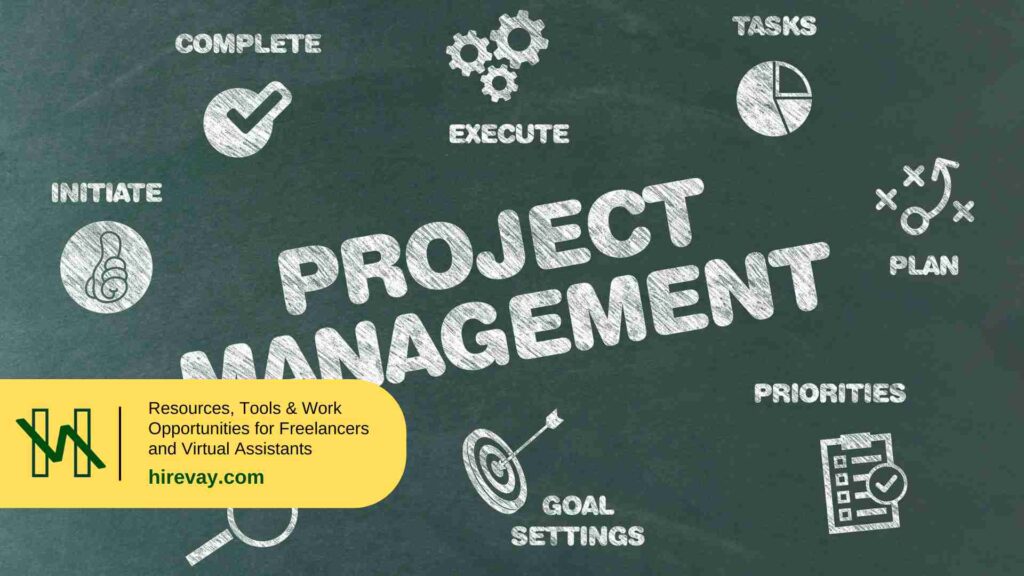Table of Contents

Introduction to Virtual Assistant Project Management
Evolution of project management in the digital age
The landscape of project management has evolved dramatically in the digital age. Traditional project management often required physical presence, manual tracking of tasks, and constant face-to-face coordination. However, with the advent of technology, we saw the introduction of several digital tools that transformed this space. These tools ranged from simple task management applications to comprehensive project management platforms like Asana, Trello, and Microsoft Project.
These advancements meant project managers (PMs) could now handle larger teams, track progress in real-time, and maintain better control over outcomes. Cloud-based software paved the way for remote collaboration, enabling teams to work together regardless of geographical boundaries.
Role transformation from traditional to virtual project management
The role of project managers has also undergone a significant transformation. Traditional PMs focused primarily on managing resources, timelines, and deliverables within a physically confined environment. Their role was heavily reliant on in-person meetings and direct supervision.
With the introduction of virtual project management, this role has expanded, requiring PMs to adeptly handle a variety of digital tools, foster virtual teamwork, and manage a distributed workforce. Communication now happens over various channels like Slack, Zoom, and Microsoft Teams, demanding proficient digital literacy. PMs must adeptly navigate time zones, ensure that team members remain engaged, and adapt management styles to suit remote work environments.
Key benefits of incorporating virtual assistants in project management
Integrating virtual assistants (VAs) into project management provides many benefits that directly enhance efficiency and productivity:
- Improved Efficiency and Productivity: VAs can undertake repetitive and time-consuming tasks, such as scheduling meetings, data entry, and follow-up reminders. This frees PMs to focus on more strategic elements of project management.
- Cost-Effective: Hiring VAs on a contractual or part-time basis reduces the significant overhead costs associated with full-time employees. Since VAs often work remotely, there’s also the added savings on infrastructure and office space.
- Scalability: VAs offer an easy way to scale your team up or down based on project requirements. This flexibility ensures that you have the right amount of resources at the right time without long-term commitments.
- 24/7 Availability: Since VAs can be sourced globally, it’s possible to find those working in different time zones. This ensures that your project can progress even when your core team is offline, effectively extending your working hours.
- Diverse Skill Sets: VAs can bring a range of specialized skills to your projects. Whether you need administrative support, technical expertise, or creative input, there’s a VA suited for almost every task.
By leveraging virtual assistants, you can transform the way projects are managed, moving towards a more efficient and scalable operation. This approach not only cuts costs but also maximizes productivity and drives project success.
Next, you will learn about the essential tools and platforms that facilitate virtual project management, and discover best practices for onboarding and training virtual assistants to seamlessly integrate them into your workflow.

Virtual Assistant Integration Strategies
Integrating virtual assistants into your project management framework is a game-changer. By adopting essential tools and platforms, adhering to best onboarding practices, and establishing effective communication protocols, you can effortlessly streamline your project workflows.
Essential Tools and Platforms for Virtual Project Management
To effectively manage virtual assistants, leveraging the right tools and platforms is crucial. Here’s a rundown of essential tools that can elevate your project management:
- Communication Tools: Tools like Slack and Microsoft Teams facilitate seamless communication. These platforms support real-time chat, video calls, file sharing, and thread conversations, ensuring that everyone stays on the same page.
- Project Management Platforms: Tools like Asana, Trello, and Jira are essential for tracking tasks and timelines. They provide an organized way to assign tasks, set deadlines, and monitor progress.
- Time-Tracking Software: Tools like Toggl and Clockify help monitor the time spent on various tasks, ensuring that virtual assistants stay productive and focused.
- File Sharing and Collaboration Tools: Google Workspace and Dropbox are indispensable for document sharing and collaborative work. They allow multiple users to work on documents simultaneously, providing version control and easy access from various locations.
By integrating these tools, you can create a robust virtual project management environment that promotes transparency, efficiency, and collaboration.
Best Practices for Onboarding and Training Virtual Assistants
Successfully integrating virtual assistants into your team requires a thorough onboarding and training process. Here are some best practices to ensure a smooth transition:
- Clear Onboarding Plan: Develop a detailed onboarding plan that introduces virtual assistants to your company’s culture, goals, and values. This plan should also outline their specific roles and responsibilities.
- Comprehensive Training Program: Provide a structured training program tailored to the virtual assistant’s role. This training should cover essential tools, project management software, and standard operating procedures.
- Regular Check-ins: Schedule regular check-ins during the initial stages to address any concerns and provide feedback. This helps build trust and ensures that virtual assistants are on the right track.
- Access to Resources: Ensure that virtual assistants have access to all necessary resources, including training materials, company handbooks, and tool guides. Providing these resources helps them perform their tasks efficiently.
By following these best practices, you can enable virtual assistants to become productive team members faster and more effectively.
Establishing Effective Communication Protocols
Effective communication is the cornerstone of successful virtual project management. Here are some strategies to establish robust communication protocols:
- Set Clear Expectations: Clearly outline communication expectations, including response times, email etiquette, and preferred communication channels. This reduces the likelihood of misunderstandings and delays.
- Regular Meetings: Schedule regular team meetings to discuss project progress, address any issues, and keep everyone aligned. Using tools like Zoom or Microsoft Teams can make virtual meetings more engaging and productive.
- Use Asynchronous Communication: Encourage the use of asynchronous communication channels like project management tools and designated email threads for non-urgent matters. This allows team members to respond at their convenience, accommodating different time zones.
- Encourage Open Dialogue: Foster an environment where virtual assistants feel comfortable voicing their concerns and suggestions. This helps build a team culture of mutual respect and continuous improvement.
Implementing effective communication protocols ensures that your virtual project management runs smoothly, regardless of geographical distances.
Transition to Future Topics
As we explore integrating virtual assistants into project management, addressing and overcoming common challenges becomes imperative. This includes tackling time zone differences, ensuring team cohesion, and maintaining security and confidentiality.
By focusing on these strategies, you can enhance your project’s efficiency and outcomes, paving the way for successful transformations in your virtual project management approach.

Real-World Success Stories
When it comes to implementing virtual assistants (VAs) in project management, real-world success stories vividly highlight the tangible benefits and improvements that organizations can achieve. This chapter covers detailed case studies, measurable improvements, and the valuable lessons learned from successful virtual assistant transformations.
Case Studies of Successful Virtual Assistant Implementations
Let’s begin by examining some prominent case studies that showcase the successful integration of virtual assistants in project management.
Global Tech Innovators
Global Tech Innovators, a leading technology solutions provider, faced the challenge of managing multiple projects across different time zones. By incorporating VAs into their project management strategy, they streamlined project documentation, scheduling, and client communication. Using tools like Asana for project tracking and Slack for communication, the organization saw a significant improvement in collaboration and overall efficiency.
Through comprehensive onboarding and training programs, as well as regular check-ins, the VAs quickly adapted to Global Tech Innovators’ workflows and contributed to faster project turnaround times.
Creative Market Place
Creative Market Place, an e-commerce platform for digital assets, also leveraged virtual assistants to manage their content creation and marketing projects. The company utilized tools such as Trello for task management, and Zoom for regular virtual meetings. This approach allowed the marketing team to handle a higher volume of projects without burnout.
The VAs were given clear communication guidelines and expectations, ensuring everyone was on the same page. The result was an evident boost in content output and higher engagement rates on their marketing campaigns.
Measurable Improvements in Project Efficiency and Outcomes
The integration of virtual assistants into project management frameworks has led to noticeable improvements in project efficiency and outcomes.
- Enhanced Productivity: Organizations such as Global Tech Innovators and Creative Market Place experienced a 30% increase in project completion rates, thanks to the dedicated support provided by VAs.
- Cost Savings: By hiring virtual assistants rather than full-time employees, companies were able to save up to 40% on overhead costs.
- Improved Communication: Regular virtual meetings and the use of communication platforms like Slack dramatically improved team collaboration and information flow.
Lessons Learned from Successful Transformations
From these success stories, several key lessons emerge that can guide organizations in their own virtual assistant integration journeys.
Thorough Onboarding Is Crucial
Both Global Tech Innovators and Creative Market Place emphasized the importance of a detailed onboarding process. This ensured that VAs were well-versed in the company’s tools, processes, and culture, allowing them to hit the ground running.
Clear Communication Protocols Foster Success
Effective communication is a cornerstone of successful remote project management. Establishing clear guidelines for communication, expectations, and regular check-ins helped maintain alignment and prevent misunderstandings.
Regular Performance Evaluations and Feedback
Providing regular feedback and conducting performance evaluations enabled companies to identify areas for improvement and recognize outstanding contributions from their virtual assistants. This ongoing dialogue supported continuous enhancement of project outcomes.
Adapting to Time Zones and Flexibility
Embracing the flexibility of remote work allowed these organizations to overcome time zone challenges. By scheduling meetings at convenient times and using asynchronous communication tools, they maintained seamless collaboration across different locations.
Through these real-world examples, the value of integrating virtual assistants in project management becomes evident. By embracing comprehensive onboarding, clear communication, regular evaluations, and flexibility, organizations can achieve remarkable improvements in project efficiency and outcomes.
As we look to the future, overcoming the challenges associated with virtual environments will be pivotal in ensuring sustained success.

Overcoming Common Challenges
Addressing Time Zone and Communication Barriers
One of the common hurdles in virtual project management is navigating time zones and ensuring smooth communication. When team members are spread across the globe, it’s vital to develop strategies to bridge these gaps effectively.
- Flexible Scheduling: Utilize a flexible scheduling approach to accommodate team members in different time zones. Tools like Google Calendar or World Time Buddy can help you find overlapping hours for real-time meetings.
- Asynchronous Communication: Adopt asynchronous communication methods for tasks that don’t require immediate feedback. Tools like Slack and email allow team members to respond at their convenience, ensuring continuous workflow regardless of time zones.
- Clear Guidelines: Develop clear guidelines for response times. For example, establishing a 24-hour response window can help manage expectations and keep projects on track.
- Regular Updates: Schedule regular updates and check-ins to keep everyone informed. This can be achieved through daily or weekly reports via project management tools like Asana or Trello.
Effective communication can mitigate the challenges of differing time zones, ensuring your virtual team remains cohesive and productive.
Maintaining Team Cohesion in Virtual Environments
Maintaining team cohesion in a virtual environment can be challenging but is crucial for a project’s success. Building a strong remote team requires deliberate actions to foster connection and collaboration.
- Team Building Activities: Include virtual team-building activities to strengthen bonds and promote a sense of belonging. Interactive online games, virtual coffee breaks, or team challenges can help build camaraderie.
- Regular Meetings: Hold regular video meetings to discuss progress, address issues, and maintain personal connections. Tools like Zoom and Microsoft Teams are excellent for virtual face-to-face interactions.
- Transparent Communication: Encourage open and transparent communication to build trust among team members. Create forums or channels where everyone can share updates, ideas, and feedback freely.
- Recognize Achievements: Acknowledge and celebrate individual and team achievements. Recognition can significantly boost morale and motivate team members to perform better.
By prioritizing team cohesion, you’ll create a collaborative and supportive virtual environment that drives project success.
Security and Confidentiality Considerations
Security and confidentiality are paramount when managing projects virtually. Ensuring sensitive information is protected requires robust protocols and tools.
- Secure Platforms: Use secure communication and project management platforms. Look for tools with end-to-end encryption like Microsoft Teams or Asana to safeguard your data.
- Access Control: Implement strict access control measures. Ensure that only authorized personnel can access specific data and that permissions are regularly reviewed and updated.
- Data Encryption: Utilize data encryption for both storage and transmission of sensitive information. Tools that provide encryption such as Dropbox or Google Drive can help protect your data.
- Regular Training: Conduct regular security training for your team. Ensure everyone is aware of best practices for maintaining confidentiality, such as recognizing phishing attempts and using strong passwords.
- Compliance: Adhere to relevant industry standards and regulations, such as GDPR or HIPAA, to ensure your project management practices are compliant with legal requirements.
By addressing these security concerns, you can protect your project and your team’s sensitive data from potential threats.
By following these strategies, you can successfully navigate the common challenges of virtual project management, ensuring your team remains productive, cohesive, and secure.

Measuring ROI and Performance
When integrating virtual assistants (VAs) into project management, understanding the return on investment (ROI) and effectively measuring performance is critical for long-term success. Let’s delve into the key performance indicators that drive virtual project management success, analyze the cost-benefit of VA integration, and explore metrics that help track project success.
Key Performance Indicators for Virtual Project Management
Key Performance Indicators (KPIs) serve as essential benchmarks to monitor the effectiveness and efficiency of integrating VAs into your project management processes. Here are some crucial KPIs to consider:
- Task Completion Rate: Measure the percentage of tasks completed on time and within quality standards.
- Project Timeliness: Track if the project milestones are being met according to the schedule.
- Cost Savings: Monitor budget adherence and any cost reductions achieved through VA integration.
- Team Productivity: Examine output levels, comparing the productivity of teams with and without VA support.
- Client Satisfaction: Collect feedback from clients to gauge their views on project delivery and the performance of your virtual team.
- Error Rates: Assess the frequency and severity of errors during project execution.
These KPIs provide a comprehensive view of the impact VAs have on project delivery and management efficiency.
Cost-Benefit Analysis of Virtual Assistant Integration
The integration of VAs is aimed at enhancing project management while cutting costs. A thorough cost-benefit analysis (CBA) helps in identifying whether VAs are providing value compared to their cost. Here’s a structured approach:
- Calculate Direct Costs: Include salaries, onboarding and training expenses, software licenses, and equipment costs for VAs.
- Estimate Indirect Costs: Consider hidden costs such as supervision, potential communication software, and integration efforts.
- Identify Financial Benefits: Measure savings from reduced workload on in-house staff, increased project throughput, and lowered operational expenses.
- Quantify Non-Financial Benefits: Evaluate improvements in flexibility, access to diverse skills, and 24/7 productivity due to VAs.
- Determine Net Benefit: Subtract the total costs from the total benefits to assess the overall financial impact.
Conducting a CBA not only highlights immediate fiscal advantages but also helps build a case for continuous VA integration.
Metrics for Tracking Project Success
Developing and maintaining metrics for project success is vital to measure the ongoing impact of VAs. Here are some high-priority metrics:
- Cycle Time: Measure the amount of time taken from project initiation to completion and compare it with industry standards.
- Resource Allocation Efficiency: Track how effectively resources, including VAs, are utilized to meet project goals without overutilization or wastage.
- Quality of Deliverables: Assess the standard of the final products or services delivered, including accuracy, completeness, and client satisfaction.
- Employee Engagement: Monitor the levels of motivation, job satisfaction, and retention rates of both in-house and virtual team members.
- Project Turnover Rates: Track the percentage of projects successfully completed versus those that face significant bottlenecks or failures.
These metrics, combined with qualitative feedback, provide deeper insights into the effectiveness of VAs in achieving project milestones and client expectations efficiently.
By implementing and meticulously monitoring these KPIs and metrics, you can confidently assess the ROI of your virtual assistant integration. This approach ensures that you are not only maximizing efficiencies but also positioning your organization for sustained success and agility in the evolving landscape of project management.

Future Trends and Opportunities
The world of virtual project management is continuously evolving, and staying ahead of the curve requires understanding emerging technologies and trends. This chapter explores the exciting advancements in virtual project management, the predicted evolution of virtual assistant (VA) capabilities, and how to prepare for the future of remote project management.
Emerging Technologies in Virtual Project Management
The integration of cutting-edge technologies is transforming the landscape of virtual project management. Here are some key technologies that are set to revolutionize the field:
- Artificial Intelligence (AI) and Machine Learning: AI and machine learning algorithms can analyze vast amounts of project data to provide insights, predict project outcomes, and automate routine tasks. These technologies can assist in project scheduling, risk management, and resource allocation, increasing efficiency and accuracy.
- Blockchain Technology: Blockchain offers a secure and transparent way to manage project transactions, contracts, and records. It ensures data integrity and reduces the risk of fraud, making it a valuable tool for maintaining confidentiality and trust in virtual project environments.
- Virtual and Augmented Reality (VR/AR): These technologies enable immersive project planning and remote collaboration by providing 3D visualizations of project designs and workflows. VR and AR can facilitate virtual meetings, site inspections, and training sessions, enhancing team engagement and understanding.
- Internet of Things (IoT): IoT devices can provide real-time data on project progress, equipment status, and environmental conditions. This data can be used to optimize project performance, predict maintenance needs, and ensure safety and compliance.
- Robotic Process Automation (RPA): RPA tools can automate repetitive and mundane tasks, allowing project managers and team members to focus on higher-value activities. From data entry to report generation, RPA can significantly reduce the administrative burden in virtual project management.
Predicted Evolution of Virtual Assistant Capabilities
As technology advances, the capabilities of virtual assistants are expected to expand, offering even greater support to project managers. Some predicted developments include:
- Enhanced Decision-Making Support: VAs will leverage AI to provide more sophisticated decision-making support, including recommending actions based on predictive analytics and past project data.
- Advanced Communication Skills: With the integration of natural language processing (NLP), VAs will be able to understand and engage in more complex and nuanced conversations, improving communication and collaboration within virtual teams.
- Proactive Issue Resolution: Future VAs will be capable of identifying potential project issues before they arise and proactively suggesting solutions, reducing delays and enhancing project outcomes.
- Adaptive Learning: VAs will continuously learn from interactions and project data to improve their performance over time, becoming more effective and personalized in their support.
Preparing for the Future of Remote Project Management
To stay competitive and ensure the success of virtual project management efforts, organizations must prepare for the future. Here are some strategies to consider:
- Invest in Technology: Stay informed about the latest tools and technologies in virtual project management and invest in solutions that align with your organization’s needs. This includes AI-powered project management software, blockchain platforms, and VR/AR tools.
- Focus on Continuous Learning: Encourage a culture of continuous learning and development within your team. Provide training on emerging technologies and foster an environment where employees can innovate and adapt to new tools and methods.
- Embrace Flexibility: Adopt flexible work practices that accommodate remote and hybrid work environments. This includes establishing clear communication protocols, promoting work-life balance, and supporting team cohesion through regular virtual team-building activities.
- Prioritize Security: With the increasing reliance on digital tools, ensuring the security and privacy of project data is paramount. Implement robust cybersecurity measures, including data encryption, access control, and regular security audits, to protect sensitive information.
- Leverage Data Analytics: Utilize data analytics to gain insights into project performance and make data-driven decisions. By analyzing historical project data, you can identify trends, optimize processes, and improve overall project outcomes.
The future of virtual project management is bright, with numerous opportunities to enhance efficiency, collaboration, and project success. By embracing emerging technologies and preparing for the evolving capabilities of virtual assistants, you can position your organization for continued growth and innovation.
Related Posts
From Struggling VA to Six-Figure Business: My 6-Month Income Transformation Blueprint
My Rock Bottom: The Starting Point Initial Struggles as a Virtual Assistant Making Less Than…
Read Post »